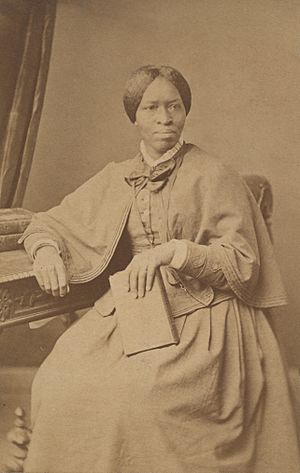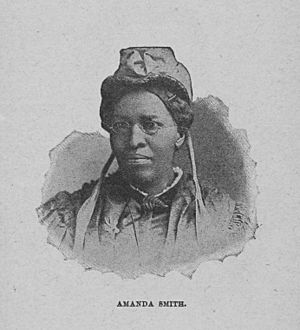Amanda Smith facts for kids
Amanda Berry Smith (born January 23, 1837 – died February 24, 1915) was an amazing woman. She was born into slavery but became a famous Methodist preacher. She started a special home for children in need near Chicago. This home was called The Amanda Smith Orphanage and Industrial Home for Abandoned and Destitute Colored Children.
Amanda was a leader in the Wesleyan-Holiness movement. She traveled all over the world, sharing her faith at church gatherings called camp meetings. People often called her "God's image carved in ebony" because of her strong faith and powerful message. Her great-great-granddaughter, Reverend Dr. A. Louise Bonaparte, is also an international preacher today.
Early Life
Amanda Smith was born into slavery in Long Green, Maryland. This was a small town in Baltimore County. Her parents were Samuel Berry and Mariam Matthews. Amanda was the oldest of their thirteen children.
Her father, Samuel, was a very trusted man. His owner's widow even put him in charge of her farm. After finishing his daily work, Mr. Berry was allowed to earn extra money. He often worked late into the night making brooms and mats. He sold these items in Baltimore to save money. His biggest goal was to buy freedom for himself and his family. After he bought his own freedom, he worked hard to free his family. Once they were all free, the Smith family moved to Pennsylvania.
Learning to Read
Unlike many enslaved children, Amanda had the chance to learn to read and write. Her father read the Bible to his family every Sunday morning. Her mother helped her learn to read before she was eight years old.
Amanda and her younger brother went to school when she was eight. The school only had classes in the summer. It closed after just six weeks. Five years later, when Amanda was 13, they had another chance to go to school. But this school was five miles from their home. They would only be taught if there was time after the white children finished their lessons. Amanda and her brother felt it wasn't worth traveling in the cold for so little learning. They dropped out after two weeks. Their parents taught them at home, and they also taught themselves.
Amanda only had about three and a half months of formal schooling. She then went to work near York, Pennsylvania. She worked as a servant for a widow with five children. While there, she went to a special church service at the Methodist Episcopal Church.
Adult Life
Amanda Smith worked as a cook and a washerwoman. She needed to support herself and her daughter. Her first husband was killed during the American Civil War. By the time Amanda was 32, she had lost two husbands and four of her five children. Going to religious camp meetings and revivals helped her deal with her sadness. These events helped her avoid feeling depressed.
She became very involved in the African Methodist Episcopal (AME) Church. There, she met Phoebe Palmer, another Methodist preacher. Phoebe was a leader in the Wesleyan-Holiness movement. In 1868, Amanda Smith said she had experienced something called "entire sanctification". This meant she felt completely devoted to God.
In 1867, a group called the National Camp Meeting Association for the Promotion of Holiness was formed. Amanda began preaching about "entire sanctification" at their camp meetings. Prayer became a very important part of her life. She trusted God for everything, like shoes, money to free her sister, and food for her family.
Amanda became well-known for her beautiful voice and inspiring teaching. This led to chances for her to preach in the South and West. African-American women in the 1800s thought carefully about how they dressed. Amanda was a preacher who traveled a lot, so she chose her clothes carefully. She always wore a simple bonnet and a brown or black Quaker-style dress. She carried her own small suitcase.
In 1878, Amanda arranged for her daughter, Mazie, to study in England. They traveled overseas and stayed in England for two years. On the ship journey, the captain asked Amanda to lead a church service. She was so humble that other passengers spread the word about her.
She then traveled to India and preached there for eighteen months. After that, Amanda spent eight years in Africa. She worked with churches and shared her faith. She traveled to Liberia and West Africa. While in Africa, she adopted two African boys. She also suffered from repeated attacks of "African Fever". But she kept working hard.
Amanda strongly supported the Temperance Movement. This movement worked to reduce alcohol use. Because of her work, she was invited to preach at a large church in Brooklyn, New York. This was the Lafayette Avenue Presbyterian Church. A famous temperance leader, Rev. Dr. Theodore Ledyard Cuyler, invited her. When she returned to America, Methodist minister Phineas Bresee also invited her to lead services. This was at Asbury Methodist Episcopal Church in May 1891.
The Orphanage
Amanda Smith raised money for The Amanda Smith Orphanage and Industrial Home for Abandoned and Destitute Colored Children. This was a place for poor and lonely children of color. The orphanage opened on June 28, 1899. It was in Harvey, a town south of Chicago. The home helped children learn to be independent.
Money for the orphanage came from many places. The Ladies Negro's Friend Society in Birmingham, UK, sent funds. Amanda traveled to many states to gather money for her work. She worked with people of all races to raise money and get advice for the home. She put a lot of energy into the orphanage.
However, the orphanage faced many challenges. There were money problems and a fire that destroyed the building. There were also disagreements between Amanda and the staff. Neighbors complained, and the home failed some inspections. Two years after Amanda's death, another fire broke out. This fire sadly killed two girls. The building was then closed for good.
Later Life and Death
In the early 1900s, Amanda Smith kept visiting different countries. She became known even more as "God's image carved in ebony." In 1912, her health started to fail. She retired to Sebring, Florida.
Her life story was published in 1893. It was called An Autobiography, The Story of the Lord's Dealing with Mrs. Amanda Smith, the Colored Evangelist Containing an Account of her Life Work of Faith, and Her Travels in America, England, Ireland, Scotland, India, and Africa, as An Independent Missionary.
Amanda Smith passed away in 1915. She was 78 years old.
See also



